Analysis of Rovio Entertainment's International Business Strategy
VerifiedAdded on 2023/01/18
|12
|3025
|82
Report
AI Summary
This report provides a comprehensive analysis of Rovio Entertainment's international business strategy, focusing on the company's response to global megatrends and its business models. The report begins with an introduction to international business strategy and an overview of Rovio Entertainment, best known for the Angry Birds franchise. Section A identifies four key global megatrends impacting the entertainment industry, including the rise of social games, freemium models, mergers and acquisitions, and augmented reality. It assesses the potential impact of these trends on Rovio's strategic position, highlighting both major threats and opportunities for the company. Section B utilizes the Business Model Canvas and relevant academic theory to critically analyze Rovio's business models. The strengths and weaknesses of these models are examined, providing insights into the company's successes and challenges. The analysis includes an examination of key partners, activities, resources, value propositions, customer relationships, channels, customer segments, cost structures, and revenue streams. The report concludes with a summary of the key findings and recommendations for Rovio Entertainment, offering a strategic roadmap for navigating the evolving landscape of the entertainment industry. The study is supported by academic theory and real-world examples to provide a well-rounded analysis of Rovio Entertainment's business strategy.

International Business Strategy
1
1
Paraphrase This Document
Need a fresh take? Get an instant paraphrase of this document with our AI Paraphraser
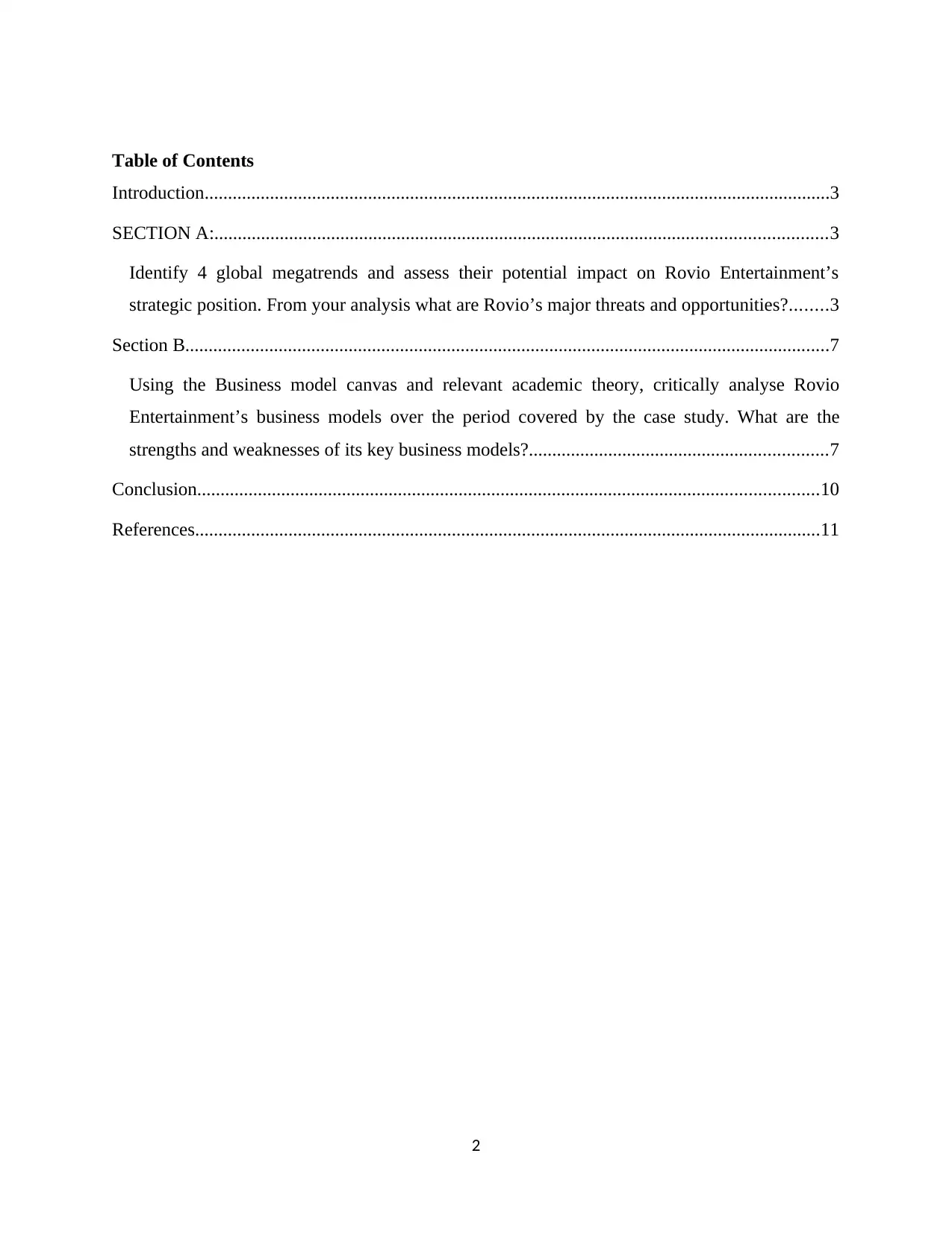
Table of Contents
Introduction......................................................................................................................................3
SECTION A:...................................................................................................................................3
Identify 4 global megatrends and assess their potential impact on Rovio Entertainment’s
strategic position. From your analysis what are Rovio’s major threats and opportunities?........3
Section B..........................................................................................................................................7
Using the Business model canvas and relevant academic theory, critically analyse Rovio
Entertainment’s business models over the period covered by the case study. What are the
strengths and weaknesses of its key business models?................................................................7
Conclusion.....................................................................................................................................10
References......................................................................................................................................11
2
Introduction......................................................................................................................................3
SECTION A:...................................................................................................................................3
Identify 4 global megatrends and assess their potential impact on Rovio Entertainment’s
strategic position. From your analysis what are Rovio’s major threats and opportunities?........3
Section B..........................................................................................................................................7
Using the Business model canvas and relevant academic theory, critically analyse Rovio
Entertainment’s business models over the period covered by the case study. What are the
strengths and weaknesses of its key business models?................................................................7
Conclusion.....................................................................................................................................10
References......................................................................................................................................11
2

Introduction
International business strategy is referred to the plan which guides commercial transactions
taking place between the entities in different countries. Generally, international business strategy
is referred to the plans and actions of private companies rather than governments. It is also
considered as a goal to increase profit (Ainamo, 2016). This study will be based on Rovio
Entertainment, best known for its Angry Bird smartphone game. The company was founded in
2003 and is based in Finland. The Angry Birds becomes the top-selling App on Apple’s App
store in 2010 and started the stream of business venture including broadcast and media, retail
stores, playgrounds and publishing. In 2010, Rovio entertainment was one of the largest
entertainment companies; though, after some years of significant growth, Rovio had to face
several challenges.
This study will state 4 global trends in the entertainment industry and its potential impact on the
company’s strategic position. The threats and opportunities of the company will also be outlined
in the study. It will then by using the business model canvas, critically analyse the key business
models of the Rovio Entertainment. All the analysis in the study will be supported by both
relevant theories and examples.
SECTION A:
Identify 4 global megatrends and assess their potential impact on Rovio Entertainment’s
strategic position. From your analysis what are Rovio’s major threats and opportunities?
In the current business scenario, entertainment trends in particular are in constant flux. The new
platforms, mediums and changing features are constantly changing the way people consume the
content. In 2018, there was a rise of game playing on the Smartphone and social media continued
to evolve into the entertainment hub (Helmhout, Deeg & Greenwood, 2016). In the current
Smartphone trend, gaming has become an important part in the entertainment industry. It has
become an unquestionable mainstream. Smartphone has become a clear winner in the giving
device industry, with 66% using it to play games. This has boosted the universal Smartphone
ownership at a global level. Gamers now have no boundaries. They no longer have to sit in the
basement, playing games in the PC console. According the data published by Ding 2018, mobile
3
International business strategy is referred to the plan which guides commercial transactions
taking place between the entities in different countries. Generally, international business strategy
is referred to the plans and actions of private companies rather than governments. It is also
considered as a goal to increase profit (Ainamo, 2016). This study will be based on Rovio
Entertainment, best known for its Angry Bird smartphone game. The company was founded in
2003 and is based in Finland. The Angry Birds becomes the top-selling App on Apple’s App
store in 2010 and started the stream of business venture including broadcast and media, retail
stores, playgrounds and publishing. In 2010, Rovio entertainment was one of the largest
entertainment companies; though, after some years of significant growth, Rovio had to face
several challenges.
This study will state 4 global trends in the entertainment industry and its potential impact on the
company’s strategic position. The threats and opportunities of the company will also be outlined
in the study. It will then by using the business model canvas, critically analyse the key business
models of the Rovio Entertainment. All the analysis in the study will be supported by both
relevant theories and examples.
SECTION A:
Identify 4 global megatrends and assess their potential impact on Rovio Entertainment’s
strategic position. From your analysis what are Rovio’s major threats and opportunities?
In the current business scenario, entertainment trends in particular are in constant flux. The new
platforms, mediums and changing features are constantly changing the way people consume the
content. In 2018, there was a rise of game playing on the Smartphone and social media continued
to evolve into the entertainment hub (Helmhout, Deeg & Greenwood, 2016). In the current
Smartphone trend, gaming has become an important part in the entertainment industry. It has
become an unquestionable mainstream. Smartphone has become a clear winner in the giving
device industry, with 66% using it to play games. This has boosted the universal Smartphone
ownership at a global level. Gamers now have no boundaries. They no longer have to sit in the
basement, playing games in the PC console. According the data published by Ding 2018, mobile
3
⊘ This is a preview!⊘
Do you want full access?
Subscribe today to unlock all pages.

Trusted by 1+ million students worldwide
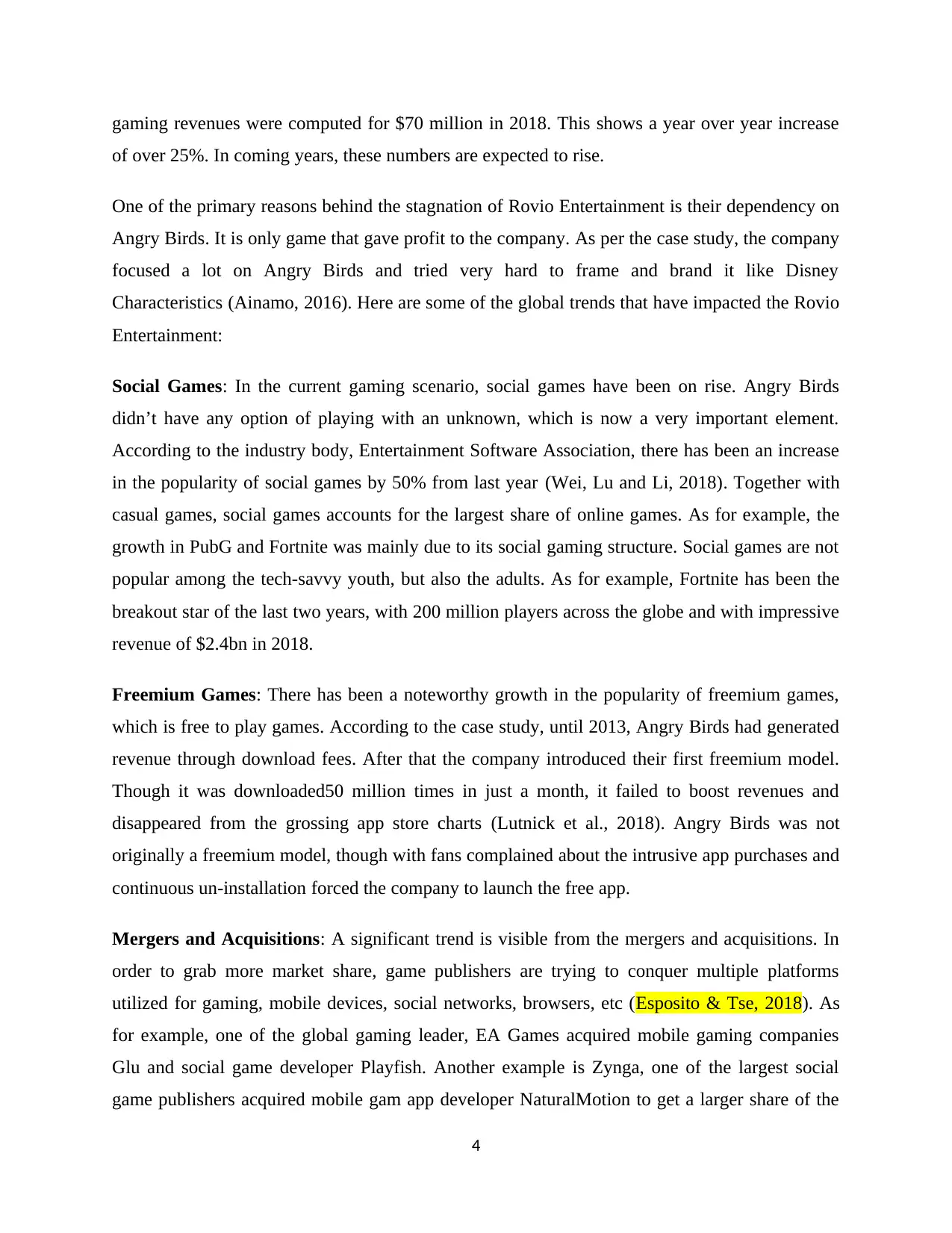
gaming revenues were computed for $70 million in 2018. This shows a year over year increase
of over 25%. In coming years, these numbers are expected to rise.
One of the primary reasons behind the stagnation of Rovio Entertainment is their dependency on
Angry Birds. It is only game that gave profit to the company. As per the case study, the company
focused a lot on Angry Birds and tried very hard to frame and brand it like Disney
Characteristics (Ainamo, 2016). Here are some of the global trends that have impacted the Rovio
Entertainment:
Social Games: In the current gaming scenario, social games have been on rise. Angry Birds
didn’t have any option of playing with an unknown, which is now a very important element.
According to the industry body, Entertainment Software Association, there has been an increase
in the popularity of social games by 50% from last year (Wei, Lu and Li, 2018). Together with
casual games, social games accounts for the largest share of online games. As for example, the
growth in PubG and Fortnite was mainly due to its social gaming structure. Social games are not
popular among the tech-savvy youth, but also the adults. As for example, Fortnite has been the
breakout star of the last two years, with 200 million players across the globe and with impressive
revenue of $2.4bn in 2018.
Freemium Games: There has been a noteworthy growth in the popularity of freemium games,
which is free to play games. According to the case study, until 2013, Angry Birds had generated
revenue through download fees. After that the company introduced their first freemium model.
Though it was downloaded50 million times in just a month, it failed to boost revenues and
disappeared from the grossing app store charts (Lutnick et al., 2018). Angry Birds was not
originally a freemium model, though with fans complained about the intrusive app purchases and
continuous un-installation forced the company to launch the free app.
Mergers and Acquisitions: A significant trend is visible from the mergers and acquisitions. In
order to grab more market share, game publishers are trying to conquer multiple platforms
utilized for gaming, mobile devices, social networks, browsers, etc (Esposito & Tse, 2018). As
for example, one of the global gaming leader, EA Games acquired mobile gaming companies
Glu and social game developer Playfish. Another example is Zynga, one of the largest social
game publishers acquired mobile gam app developer NaturalMotion to get a larger share of the
4
of over 25%. In coming years, these numbers are expected to rise.
One of the primary reasons behind the stagnation of Rovio Entertainment is their dependency on
Angry Birds. It is only game that gave profit to the company. As per the case study, the company
focused a lot on Angry Birds and tried very hard to frame and brand it like Disney
Characteristics (Ainamo, 2016). Here are some of the global trends that have impacted the Rovio
Entertainment:
Social Games: In the current gaming scenario, social games have been on rise. Angry Birds
didn’t have any option of playing with an unknown, which is now a very important element.
According to the industry body, Entertainment Software Association, there has been an increase
in the popularity of social games by 50% from last year (Wei, Lu and Li, 2018). Together with
casual games, social games accounts for the largest share of online games. As for example, the
growth in PubG and Fortnite was mainly due to its social gaming structure. Social games are not
popular among the tech-savvy youth, but also the adults. As for example, Fortnite has been the
breakout star of the last two years, with 200 million players across the globe and with impressive
revenue of $2.4bn in 2018.
Freemium Games: There has been a noteworthy growth in the popularity of freemium games,
which is free to play games. According to the case study, until 2013, Angry Birds had generated
revenue through download fees. After that the company introduced their first freemium model.
Though it was downloaded50 million times in just a month, it failed to boost revenues and
disappeared from the grossing app store charts (Lutnick et al., 2018). Angry Birds was not
originally a freemium model, though with fans complained about the intrusive app purchases and
continuous un-installation forced the company to launch the free app.
Mergers and Acquisitions: A significant trend is visible from the mergers and acquisitions. In
order to grab more market share, game publishers are trying to conquer multiple platforms
utilized for gaming, mobile devices, social networks, browsers, etc (Esposito & Tse, 2018). As
for example, one of the global gaming leader, EA Games acquired mobile gaming companies
Glu and social game developer Playfish. Another example is Zynga, one of the largest social
game publishers acquired mobile gam app developer NaturalMotion to get a larger share of the
4
Paraphrase This Document
Need a fresh take? Get an instant paraphrase of this document with our AI Paraphraser
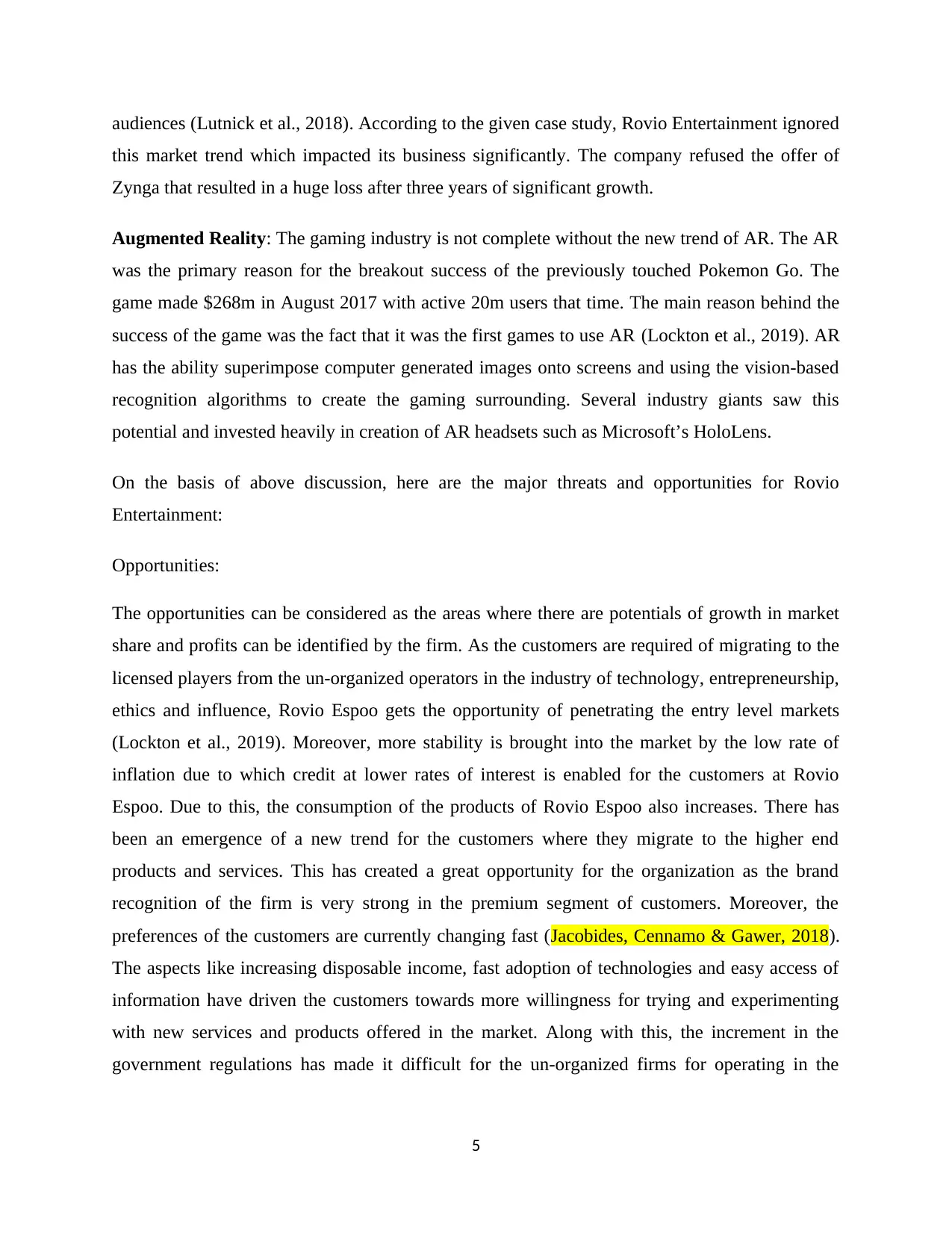
audiences (Lutnick et al., 2018). According to the given case study, Rovio Entertainment ignored
this market trend which impacted its business significantly. The company refused the offer of
Zynga that resulted in a huge loss after three years of significant growth.
Augmented Reality: The gaming industry is not complete without the new trend of AR. The AR
was the primary reason for the breakout success of the previously touched Pokemon Go. The
game made $268m in August 2017 with active 20m users that time. The main reason behind the
success of the game was the fact that it was the first games to use AR (Lockton et al., 2019). AR
has the ability superimpose computer generated images onto screens and using the vision-based
recognition algorithms to create the gaming surrounding. Several industry giants saw this
potential and invested heavily in creation of AR headsets such as Microsoft’s HoloLens.
On the basis of above discussion, here are the major threats and opportunities for Rovio
Entertainment:
Opportunities:
The opportunities can be considered as the areas where there are potentials of growth in market
share and profits can be identified by the firm. As the customers are required of migrating to the
licensed players from the un-organized operators in the industry of technology, entrepreneurship,
ethics and influence, Rovio Espoo gets the opportunity of penetrating the entry level markets
(Lockton et al., 2019). Moreover, more stability is brought into the market by the low rate of
inflation due to which credit at lower rates of interest is enabled for the customers at Rovio
Espoo. Due to this, the consumption of the products of Rovio Espoo also increases. There has
been an emergence of a new trend for the customers where they migrate to the higher end
products and services. This has created a great opportunity for the organization as the brand
recognition of the firm is very strong in the premium segment of customers. Moreover, the
preferences of the customers are currently changing fast (Jacobides, Cennamo & Gawer, 2018).
The aspects like increasing disposable income, fast adoption of technologies and easy access of
information have driven the customers towards more willingness for trying and experimenting
with new services and products offered in the market. Along with this, the increment in the
government regulations has made it difficult for the un-organized firms for operating in the
5
this market trend which impacted its business significantly. The company refused the offer of
Zynga that resulted in a huge loss after three years of significant growth.
Augmented Reality: The gaming industry is not complete without the new trend of AR. The AR
was the primary reason for the breakout success of the previously touched Pokemon Go. The
game made $268m in August 2017 with active 20m users that time. The main reason behind the
success of the game was the fact that it was the first games to use AR (Lockton et al., 2019). AR
has the ability superimpose computer generated images onto screens and using the vision-based
recognition algorithms to create the gaming surrounding. Several industry giants saw this
potential and invested heavily in creation of AR headsets such as Microsoft’s HoloLens.
On the basis of above discussion, here are the major threats and opportunities for Rovio
Entertainment:
Opportunities:
The opportunities can be considered as the areas where there are potentials of growth in market
share and profits can be identified by the firm. As the customers are required of migrating to the
licensed players from the un-organized operators in the industry of technology, entrepreneurship,
ethics and influence, Rovio Espoo gets the opportunity of penetrating the entry level markets
(Lockton et al., 2019). Moreover, more stability is brought into the market by the low rate of
inflation due to which credit at lower rates of interest is enabled for the customers at Rovio
Espoo. Due to this, the consumption of the products of Rovio Espoo also increases. There has
been an emergence of a new trend for the customers where they migrate to the higher end
products and services. This has created a great opportunity for the organization as the brand
recognition of the firm is very strong in the premium segment of customers. Moreover, the
preferences of the customers are currently changing fast (Jacobides, Cennamo & Gawer, 2018).
The aspects like increasing disposable income, fast adoption of technologies and easy access of
information have driven the customers towards more willingness for trying and experimenting
with new services and products offered in the market. Along with this, the increment in the
government regulations has made it difficult for the un-organized firms for operating in the
5

industry of technology, influence, ethics and entrepreneurship. This has provided huge
opportunities to Rovio Espoo for increasing its customer base.
Threats:
With the retiring of the babyboomers, it has become very difficult for the new generation to
replace the purchasing power. This can lead to the increment of the profits but it might reduce
the long-term margins as brand loyalty of the young customers is very low. Although being a
leader in the product innovation aspect of the industry of innovation and entrepreneurship, some
stiff challenges are still faced by the organization from the local and international competitors
(Liu and Li, 2012). Moreover, as per the increasing dependence of the firm on innovative
solutions and high turnover of the firm’s employees, it can be estimated that the firm might
challenges in acquiring skill human resource in the upcoming future (McGahan, 2014). Other
than this, the potentiality of losing the intellectual property is the biggest threat for the
organization that can occur from the tie-ups developed by the firm with the local players present
in the sector. The emerging market like China does not have strong frameworks for intellectual
property rights (Wei, Lu and Li, 2018). The main reason behind this is the growth of the
technological expertise of the local business operators in the market.
6
opportunities to Rovio Espoo for increasing its customer base.
Threats:
With the retiring of the babyboomers, it has become very difficult for the new generation to
replace the purchasing power. This can lead to the increment of the profits but it might reduce
the long-term margins as brand loyalty of the young customers is very low. Although being a
leader in the product innovation aspect of the industry of innovation and entrepreneurship, some
stiff challenges are still faced by the organization from the local and international competitors
(Liu and Li, 2012). Moreover, as per the increasing dependence of the firm on innovative
solutions and high turnover of the firm’s employees, it can be estimated that the firm might
challenges in acquiring skill human resource in the upcoming future (McGahan, 2014). Other
than this, the potentiality of losing the intellectual property is the biggest threat for the
organization that can occur from the tie-ups developed by the firm with the local players present
in the sector. The emerging market like China does not have strong frameworks for intellectual
property rights (Wei, Lu and Li, 2018). The main reason behind this is the growth of the
technological expertise of the local business operators in the market.
6
⊘ This is a preview!⊘
Do you want full access?
Subscribe today to unlock all pages.

Trusted by 1+ million students worldwide

Section B
Using the Business model canvas and relevant academic theory, critically analyse Rovio
Entertainment’s business models over the period covered by the case study. What are the
strengths and weaknesses of its key business models?
Business model canvas of Rovio Entertainment
Key Partners
Smartphon
e
Operating
System
Third-
party
video
distributio
n
platforms
Parks and
Attraction
s
Media
(Sony
pictures
and
Columbia
pictures)
Key Activities
Software
developm
ent
Products
developm
ent
Licensing
Third
party
integration
s
Game
Design
Value Propositions
Multi colours
birds who try
to save their
eggs from
green
coloured pigs
The game
was once
called as one
the most
mainstream
games
Multi
product
One radical
new product
Customer
relationships
Time
Killer
Highly
addictive
Simple
Viral
Multi-
platform
Customer
Segments
Nich
e
Mark
et
Mult
i-
sided
mark
et
Mass
Mark
et
Key Resources
Innovation
Word-of-
mouth
Big Data
Channels
Android
Market
App store
Windows
Park
7
Using the Business model canvas and relevant academic theory, critically analyse Rovio
Entertainment’s business models over the period covered by the case study. What are the
strengths and weaknesses of its key business models?
Business model canvas of Rovio Entertainment
Key Partners
Smartphon
e
Operating
System
Third-
party
video
distributio
n
platforms
Parks and
Attraction
s
Media
(Sony
pictures
and
Columbia
pictures)
Key Activities
Software
developm
ent
Products
developm
ent
Licensing
Third
party
integration
s
Game
Design
Value Propositions
Multi colours
birds who try
to save their
eggs from
green
coloured pigs
The game
was once
called as one
the most
mainstream
games
Multi
product
One radical
new product
Customer
relationships
Time
Killer
Highly
addictive
Simple
Viral
Multi-
platform
Customer
Segments
Nich
e
Mark
et
Mult
i-
sided
mark
et
Mass
Mark
et
Key Resources
Innovation
Word-of-
mouth
Big Data
Channels
Android
Market
App store
Windows
Park
7
Paraphrase This Document
Need a fresh take? Get an instant paraphrase of this document with our AI Paraphraser
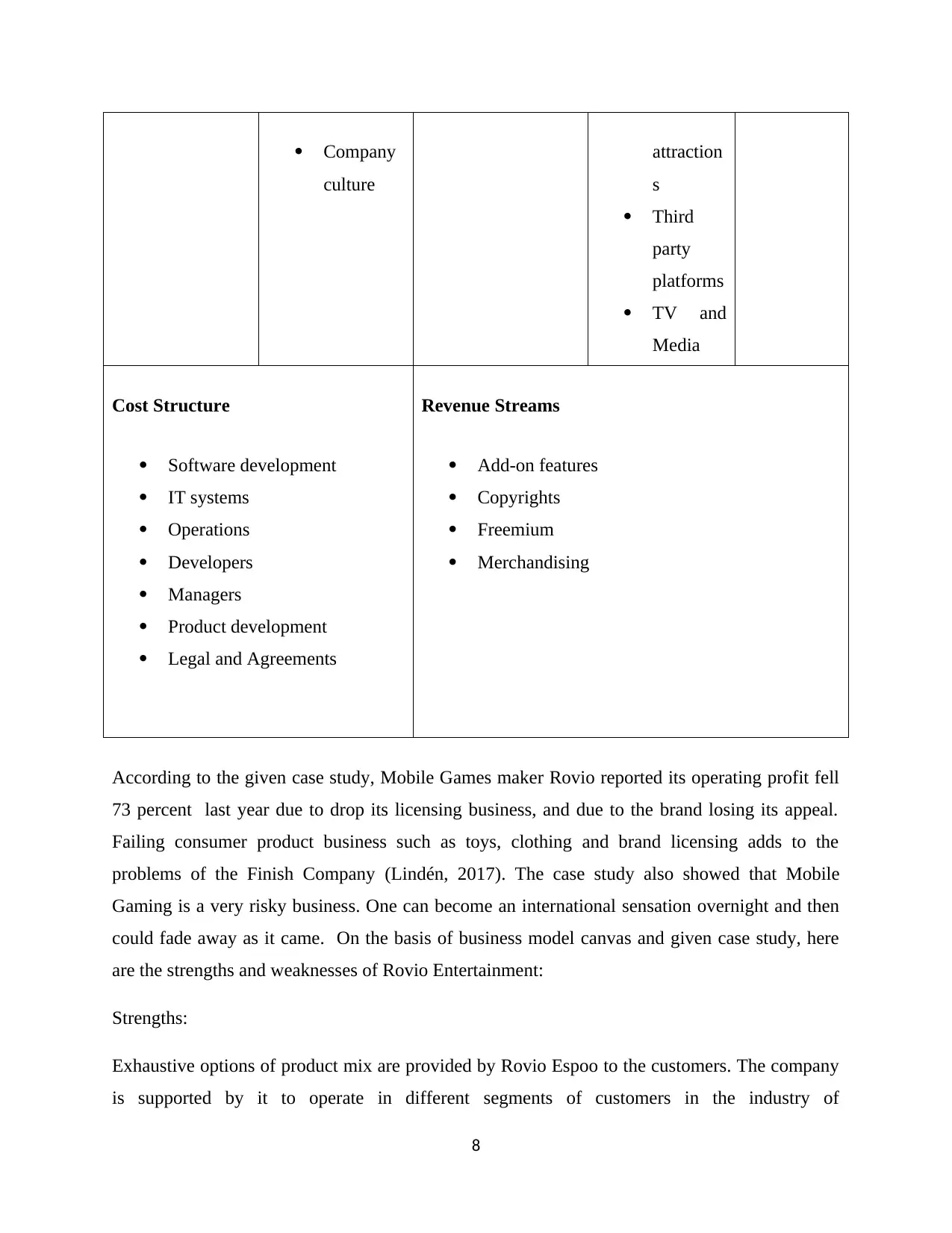
Company
culture
attraction
s
Third
party
platforms
TV and
Media
Cost Structure
Software development
IT systems
Operations
Developers
Managers
Product development
Legal and Agreements
Revenue Streams
Add-on features
Copyrights
Freemium
Merchandising
According to the given case study, Mobile Games maker Rovio reported its operating profit fell
73 percent last year due to drop its licensing business, and due to the brand losing its appeal.
Failing consumer product business such as toys, clothing and brand licensing adds to the
problems of the Finish Company (Lindén, 2017). The case study also showed that Mobile
Gaming is a very risky business. One can become an international sensation overnight and then
could fade away as it came. On the basis of business model canvas and given case study, here
are the strengths and weaknesses of Rovio Entertainment:
Strengths:
Exhaustive options of product mix are provided by Rovio Espoo to the customers. The company
is supported by it to operate in different segments of customers in the industry of
8
culture
attraction
s
Third
party
platforms
TV and
Media
Cost Structure
Software development
IT systems
Operations
Developers
Managers
Product development
Legal and Agreements
Revenue Streams
Add-on features
Copyrights
Freemium
Merchandising
According to the given case study, Mobile Games maker Rovio reported its operating profit fell
73 percent last year due to drop its licensing business, and due to the brand losing its appeal.
Failing consumer product business such as toys, clothing and brand licensing adds to the
problems of the Finish Company (Lindén, 2017). The case study also showed that Mobile
Gaming is a very risky business. One can become an international sensation overnight and then
could fade away as it came. On the basis of business model canvas and given case study, here
are the strengths and weaknesses of Rovio Entertainment:
Strengths:
Exhaustive options of product mix are provided by Rovio Espoo to the customers. The company
is supported by it to operate in different segments of customers in the industry of
8
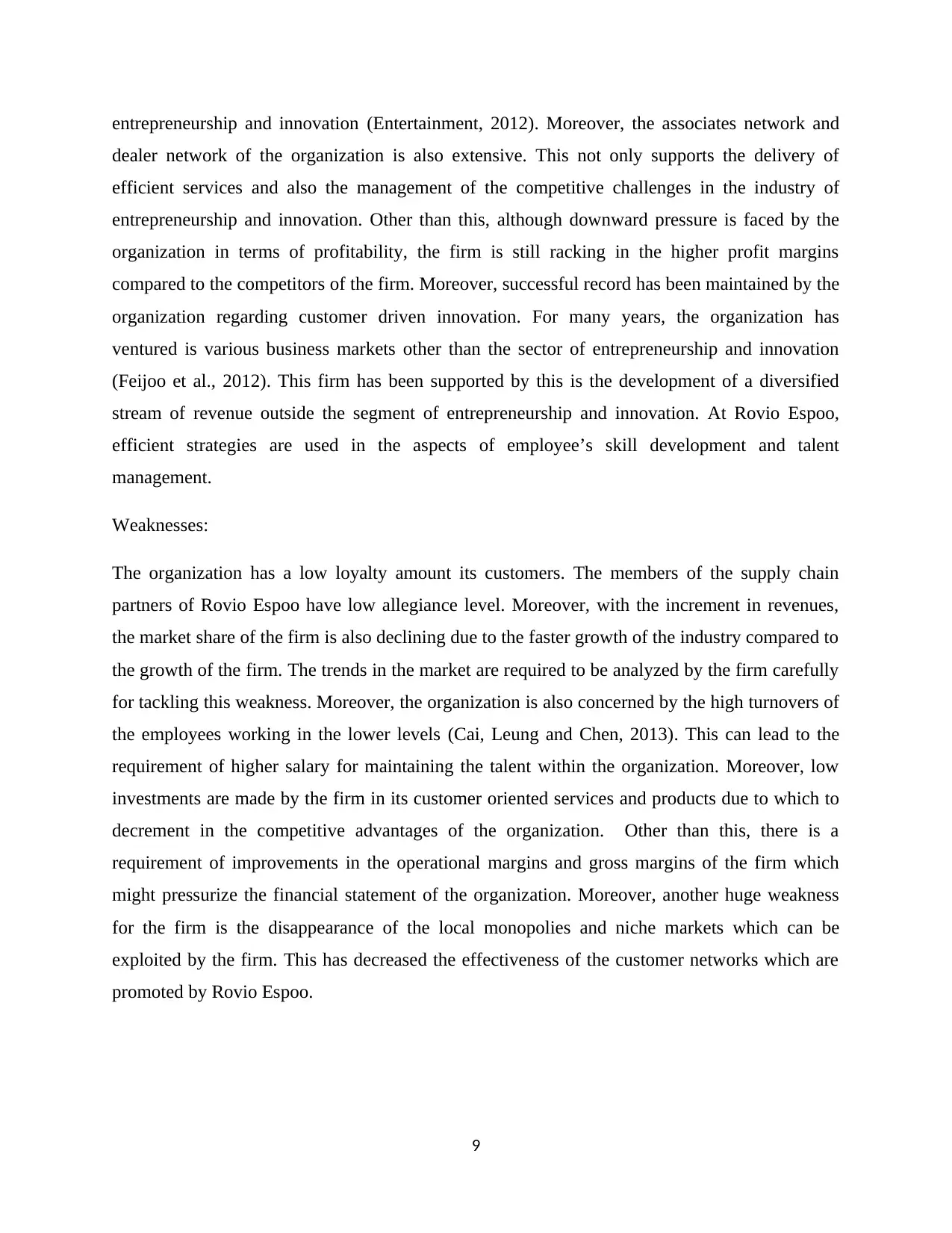
entrepreneurship and innovation (Entertainment, 2012). Moreover, the associates network and
dealer network of the organization is also extensive. This not only supports the delivery of
efficient services and also the management of the competitive challenges in the industry of
entrepreneurship and innovation. Other than this, although downward pressure is faced by the
organization in terms of profitability, the firm is still racking in the higher profit margins
compared to the competitors of the firm. Moreover, successful record has been maintained by the
organization regarding customer driven innovation. For many years, the organization has
ventured is various business markets other than the sector of entrepreneurship and innovation
(Feijoo et al., 2012). This firm has been supported by this is the development of a diversified
stream of revenue outside the segment of entrepreneurship and innovation. At Rovio Espoo,
efficient strategies are used in the aspects of employee’s skill development and talent
management.
Weaknesses:
The organization has a low loyalty amount its customers. The members of the supply chain
partners of Rovio Espoo have low allegiance level. Moreover, with the increment in revenues,
the market share of the firm is also declining due to the faster growth of the industry compared to
the growth of the firm. The trends in the market are required to be analyzed by the firm carefully
for tackling this weakness. Moreover, the organization is also concerned by the high turnovers of
the employees working in the lower levels (Cai, Leung and Chen, 2013). This can lead to the
requirement of higher salary for maintaining the talent within the organization. Moreover, low
investments are made by the firm in its customer oriented services and products due to which to
decrement in the competitive advantages of the organization. Other than this, there is a
requirement of improvements in the operational margins and gross margins of the firm which
might pressurize the financial statement of the organization. Moreover, another huge weakness
for the firm is the disappearance of the local monopolies and niche markets which can be
exploited by the firm. This has decreased the effectiveness of the customer networks which are
promoted by Rovio Espoo.
9
dealer network of the organization is also extensive. This not only supports the delivery of
efficient services and also the management of the competitive challenges in the industry of
entrepreneurship and innovation. Other than this, although downward pressure is faced by the
organization in terms of profitability, the firm is still racking in the higher profit margins
compared to the competitors of the firm. Moreover, successful record has been maintained by the
organization regarding customer driven innovation. For many years, the organization has
ventured is various business markets other than the sector of entrepreneurship and innovation
(Feijoo et al., 2012). This firm has been supported by this is the development of a diversified
stream of revenue outside the segment of entrepreneurship and innovation. At Rovio Espoo,
efficient strategies are used in the aspects of employee’s skill development and talent
management.
Weaknesses:
The organization has a low loyalty amount its customers. The members of the supply chain
partners of Rovio Espoo have low allegiance level. Moreover, with the increment in revenues,
the market share of the firm is also declining due to the faster growth of the industry compared to
the growth of the firm. The trends in the market are required to be analyzed by the firm carefully
for tackling this weakness. Moreover, the organization is also concerned by the high turnovers of
the employees working in the lower levels (Cai, Leung and Chen, 2013). This can lead to the
requirement of higher salary for maintaining the talent within the organization. Moreover, low
investments are made by the firm in its customer oriented services and products due to which to
decrement in the competitive advantages of the organization. Other than this, there is a
requirement of improvements in the operational margins and gross margins of the firm which
might pressurize the financial statement of the organization. Moreover, another huge weakness
for the firm is the disappearance of the local monopolies and niche markets which can be
exploited by the firm. This has decreased the effectiveness of the customer networks which are
promoted by Rovio Espoo.
9
⊘ This is a preview!⊘
Do you want full access?
Subscribe today to unlock all pages.

Trusted by 1+ million students worldwide
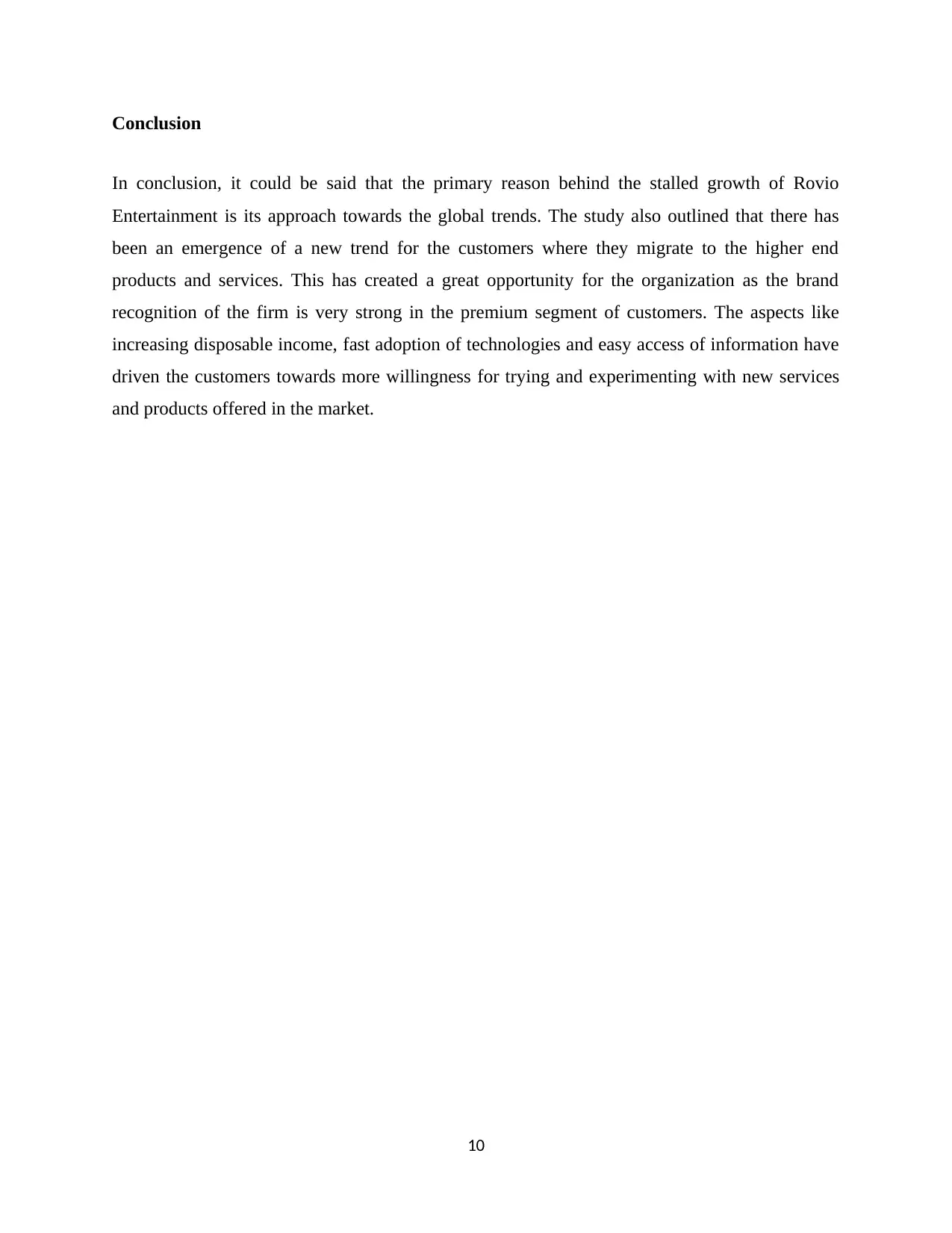
Conclusion
In conclusion, it could be said that the primary reason behind the stalled growth of Rovio
Entertainment is its approach towards the global trends. The study also outlined that there has
been an emergence of a new trend for the customers where they migrate to the higher end
products and services. This has created a great opportunity for the organization as the brand
recognition of the firm is very strong in the premium segment of customers. The aspects like
increasing disposable income, fast adoption of technologies and easy access of information have
driven the customers towards more willingness for trying and experimenting with new services
and products offered in the market.
10
In conclusion, it could be said that the primary reason behind the stalled growth of Rovio
Entertainment is its approach towards the global trends. The study also outlined that there has
been an emergence of a new trend for the customers where they migrate to the higher end
products and services. This has created a great opportunity for the organization as the brand
recognition of the firm is very strong in the premium segment of customers. The aspects like
increasing disposable income, fast adoption of technologies and easy access of information have
driven the customers towards more willingness for trying and experimenting with new services
and products offered in the market.
10
Paraphrase This Document
Need a fresh take? Get an instant paraphrase of this document with our AI Paraphraser

References
Ainamo, A., 2016. Case study of Rovio Entertainment and “Angry Birds”.
Cai, W., Leung, V.C. and Chen, M., 2013, March. Next generation mobile cloud gaming.
In 2013 IEEE Seventh International Symposium on Service-Oriented System Engineering (pp.
551-560). IEEE.
Ding, Y., 2018. Research on operational model of PUBG. In MATEC Web of Conferences (Vol.
173, p. 03062). EDP Sciences.
Entertainment, R., 2012. Angry Birds Space. iOS. Espoo, Finland: Rovio Entertainment.
Esposito, M. & Tse, T. (2018) "DRIVE: The Five Megatrends that Underpin the Future
Business, Social, and Economic Landscapes", Thunderbird International Business Review, vol.
60, no. 1, pp. 121-129.
Feijoo, C., Gómez-Barroso, J.L., Aguado, J.M. and Ramos, S., 2012. Mobile gaming: Industry
challenges and policy implications. Telecommunications Policy, 36(3), pp.212-221.
Jacobides, M.G., Cennamo, C. & Gawer, A. (2018) "Towards a theory of ecosystems", Strategic
Management Journal, vol. 39, no. 8, pp. 2255-2276.
Lindén, J., 2017. Developing employer brand to attract talent: case: Rovio Entertainment
Corporation.
Liu, C. and Li, Y., 2012. Rovio and Angry Birds.
Lockton, D.B., Berner, M.K. and Micheli, M.J., Winview Inc, 2019. Methods and apparatus for
distributed gaming over a mobile device. U.S. Patent Application 10/232,270.
Lutnick, H.W., Burman, K., Alderucci, D.P., Gelman, G.M. and Miller, M., CFPH LLC,
2018. Method and apparatus for advertising on a mobile gaming device. U.S. Patent 9,940,643.
McGahan, A.M. (2014) How Industries Evolve. In De Wit & Meyer, 2011. Ch.10 in Strategy:
An International Perspective,5th Edition by De Wit and Meyer: Cengage.
11
Ainamo, A., 2016. Case study of Rovio Entertainment and “Angry Birds”.
Cai, W., Leung, V.C. and Chen, M., 2013, March. Next generation mobile cloud gaming.
In 2013 IEEE Seventh International Symposium on Service-Oriented System Engineering (pp.
551-560). IEEE.
Ding, Y., 2018. Research on operational model of PUBG. In MATEC Web of Conferences (Vol.
173, p. 03062). EDP Sciences.
Entertainment, R., 2012. Angry Birds Space. iOS. Espoo, Finland: Rovio Entertainment.
Esposito, M. & Tse, T. (2018) "DRIVE: The Five Megatrends that Underpin the Future
Business, Social, and Economic Landscapes", Thunderbird International Business Review, vol.
60, no. 1, pp. 121-129.
Feijoo, C., Gómez-Barroso, J.L., Aguado, J.M. and Ramos, S., 2012. Mobile gaming: Industry
challenges and policy implications. Telecommunications Policy, 36(3), pp.212-221.
Jacobides, M.G., Cennamo, C. & Gawer, A. (2018) "Towards a theory of ecosystems", Strategic
Management Journal, vol. 39, no. 8, pp. 2255-2276.
Lindén, J., 2017. Developing employer brand to attract talent: case: Rovio Entertainment
Corporation.
Liu, C. and Li, Y., 2012. Rovio and Angry Birds.
Lockton, D.B., Berner, M.K. and Micheli, M.J., Winview Inc, 2019. Methods and apparatus for
distributed gaming over a mobile device. U.S. Patent Application 10/232,270.
Lutnick, H.W., Burman, K., Alderucci, D.P., Gelman, G.M. and Miller, M., CFPH LLC,
2018. Method and apparatus for advertising on a mobile gaming device. U.S. Patent 9,940,643.
McGahan, A.M. (2014) How Industries Evolve. In De Wit & Meyer, 2011. Ch.10 in Strategy:
An International Perspective,5th Edition by De Wit and Meyer: Cengage.
11
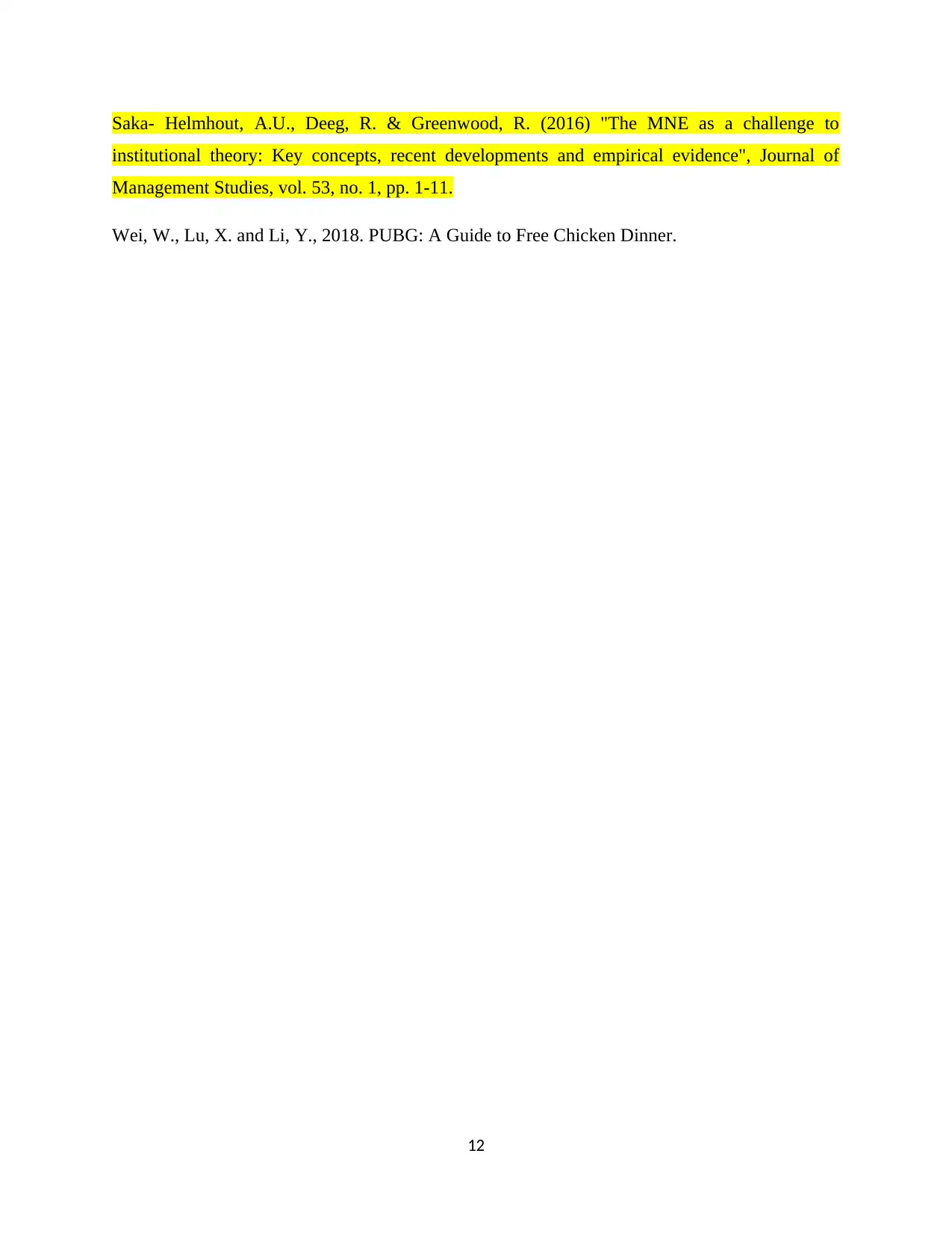
Saka- Helmhout, A.U., Deeg, R. & Greenwood, R. (2016) "The MNE as a challenge to
institutional theory: Key concepts, recent developments and empirical evidence", Journal of
Management Studies, vol. 53, no. 1, pp. 1-11.
Wei, W., Lu, X. and Li, Y., 2018. PUBG: A Guide to Free Chicken Dinner.
12
institutional theory: Key concepts, recent developments and empirical evidence", Journal of
Management Studies, vol. 53, no. 1, pp. 1-11.
Wei, W., Lu, X. and Li, Y., 2018. PUBG: A Guide to Free Chicken Dinner.
12
⊘ This is a preview!⊘
Do you want full access?
Subscribe today to unlock all pages.

Trusted by 1+ million students worldwide
1 out of 12
Related Documents
Your All-in-One AI-Powered Toolkit for Academic Success.
+13062052269
info@desklib.com
Available 24*7 on WhatsApp / Email
![[object Object]](/_next/static/media/star-bottom.7253800d.svg)
Unlock your academic potential
Copyright © 2020–2025 A2Z Services. All Rights Reserved. Developed and managed by ZUCOL.





